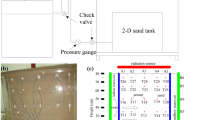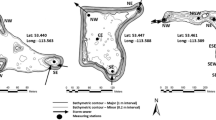Abstract
Numerical modeling is needed to predict environmental temperatures, which affect a number of biota in southern Florida, U.S.A., such as the West Indian manatee (Trichechus manatus), which uses thermal basins for refuge from lethal winter cold fronts. To numerically simulate heat-transport through a dynamic coastal wetland region, an algorithm was developed for the FTLOADDS coupled hydrodynamic surface-water/ground-water model that uses formulations and coefficients suited to the coastal wetland thermal environment. In this study, two field sites provided atmospheric data to develop coefficients for the heat flux terms representing this particular study area. Several methods were examined to represent the heat-flux components used to compute temperature. A Dalton equation was compared with a Penman formulation for latent heat computations, producing similar daily-average temperatures. Simulation of heat-transport in the southern Everglades indicates that the model represents the daily fluctuation in coastal temperatures better than at inland locations; possibly due to the lack of information on the spatial variations in heat-transport parameters such as soil heat capacity and surface albedo. These simulation results indicate that the new formulation is suitable for defining the existing thermohydrologic system and evaluating the ecological effect of proposed restoration efforts in the southern Everglades of Florida.








Similar content being viewed by others
References
Abtew W (2005) Evapotranspiration in the Everglades: comparison of Bowen Ratio measurements and model estimations. ASAE Paper 052188, Tampa FL
Anderson MP (2005) Heat as a ground water tracer. Ground Water 43(6):951–968
Barenbrug AWT (1974) Psychrometry and psychrometric charts, 3rd edn. Cape and Transvaal Printers Ltd, Cape Town
Berger X, Buriot D, Garnier F (1984) About the equivalent radiative temperature for clear skies. Solar Energy 32:725–733
Bolton D (1980) The computation of equivalent potential temperature. Monthly Weather Review 108(7):1046–1053
Bossart GD, Meisner RA, Rommel SA, Ghim S-J, Jenson AB (2003) Pathological features of the Florida manatee cold stress syndrome. Aquatic Mammals 29(1):9–17
Bradley A, Allen H, Forrest M Jr, Walker WK, Wright SA (1998) Estimation of water temperature exceedance probabilities using thermo-hydrodynamic modeling. Journal of the American Water Resources Association 34(3):467–480
Bravo HR, F Jiang, Hunt RJ (2000) Improving wetland simulations by coupling groundwater flow and heat transport modeling. In Proceedings of 4th International Conference Hydro-Informatics 2000, Cedar Rapids, Iowa
Brunt D (1932) Notes on radiation in the atmosphere. Quarterly Journal Royal Meteorological Society 58:389–420
Brutsaert W (1982) Evaporation into the atmosphere. Kluwer Academic Publishers, Netherlands
Cole T (2000) Reservoir thermal modeling. Proceedings of HydroInformatics 2000 Iowa City, IAHR, CDROM EW5
Eagleson PS (1970) Dynamic hydrology. McGraw-Hill, New York
Garrett A (1977) A comparison of the observed longwave radiation flux to calculations based on Kondratyev’s and Brunt’s methods. Theoretical and Applied Climatology 25:127–134
German E (2000) Regional evaluation of evapotranspiration in the Everglades. U.S. Geological Survey Water-Resources Investigations Report 00–4217
Guo W, Langevin CD (2002) User’s guide to SEAWAT: A computer program for simulation of three-dimensional variable-density ground-water flow. U.S. Geological Survey Techniques of Water-Resources Investigations, book 6, chap. A7
Iziomon M, Mayer H, Matzarakis A (2003) Downward atmospheric longwave irradiance under clear skies: measurement and parameterization. Journal of Atmospheric and Solar-Terrestrial Physics 65:1107–1116
Jacobs J, Myers D, Anderson M, Diak G (2002) GOES surface insolation to estimate wetlands evapotranspiration. Journal of Hydrology 266:53–65
Jedrasik J (1997) A model of matter exchange and flow of energy in the Gulf of Gdansk ecosystem—overview. Oceanological Studies 26(4):3–20
Jin K-R, Hamrick JH, Tisdale T (2000) Application of three-dimensional hydrodynamic model for Lake Okeechobee. Journal of Hydraulic Engineering 126(10):758–771
Kim KS, Chapra SC (1997) Temperature model for highly transient shallow streams. Journal of Hydraulic Engineering 123(1):30–40
Langevin CD, Swain ED, Wolfert MA (2005) Simulation of integrated surface-water/ground-water flow and salinity for a coastal wetland and adjacent estuary. Journal of Hydrology 314:212–234
Leendertse JJ (1987) Aspects of SIMSYS2D, a system for two-dimensional flow computation. Santa Monica, Calif., Rand Corporation Report R-3611-Netherlands
Lowry CS, Anderson MP, Hunt RJ (2006) Modeling groundwater flow and heat transport within a fen/stream complex. Proceedings of MODFLOW and MORE 2006: Managing Groundwater Systems, pp 278–282
McKenzie JM, Voss CI, Siegel DI (2007) Groundwater flow with energy transport and water-ice phase change: numerical simulations, benchmarks, and application to freezing in peat bogs. Advances in Water Resources 30(4):966–983
Monteith J (1961) An empirical method for estimating long-wave radiation exchanges in the British Isles. Quarterly Journal Royal Meteorological Society 87:171–179
RECOVER (2005) RECOVER’s initial comprehensive Everglades restoration plan update report. Available at http://www.evergladesplan.org/pm/recover/icu.aspx
Schaffranek RW (2004) Simulation of surface-water integrated flow and transport in two dimensions: SWIFT2D user’s manual. U.S. Geological Survey Techniques and Methods, book 6, chap B-1
Seager R, Blumenthal MB (1994) Modeling tropical Pacific sea surface temperature with satellite-derived solar radiative forcing. Journal of Climate 7:1944–1957
Shoemaker WB, Sumner DM (2006) Alternative corrections for estimating actual wetland evapotranspiration from potential evapotranspiration. Wetlands 26(2):528–543
Shoemaker WB, Huddleston S, Boudreau C, O’Reilly AM (2008) Sensitivity of wetlands saturated hydraulic heads and water budgets to evapotranspiration. Wetlands 28(4):1040–1047
Swain ED (2005) A model for simulation of surface-water integrated flow and transport in two dimensions: user’s guide for application to coastal wetlands. U.S. Geological Survey Open-File Report 2005–1033
Swain ED, Wolfert MA, Bales JD, Goodwin CR (2004) Two-dimensional hydrodynamic simulation of surface-water flow and transport to Florida Bay through the Southern Inland and Coastal Systems (SICS). USGS Water-Resources Investigations Report 03–4287
Swain ED, Lohmann M, Decker JD (2008) Hydrologic simulations of water-management scenarios in support of the comprehensive Everglades restoration plan. The role of hydrology in water resources management: IAHS Red Book Series, UNESCO/IAHS Symposium, October 2008, Isle of Capri, Napoli, Italy
Thorne D, Langevin CD, Sukop MC (2006) Addition of simultaneous heat and solute transport and variable fluid viscosity to SEAWAT. Computers and Geosciences 32:1758–1768
Viswanadham Y, Ramanadham R (1970) Estimation of long wave radiation by an empirical method. Pure and Applied Geophysics 81:272–278
Wang JD, Swain ED, Wolfert MA, Langevin CD, James DE, Telis PA (2007) Applications of Flow and Transport in a Linked Overland/Aquifer Density Dependent System (FTLOADDS) to simulate flow, salinity, and surface-water stage in the Southern Everglades, Florida. U.S. Geological Survey Scientific Investigations Report 2007–5010
Weller R, Rudnick D, Brink NJ (1995) Meteorological variability and air-sea fluxes at a closely spaced array of surface moorings. Journal of Geophysical Research 100:4867–4883
Acknowledgments
The authors wish to thank the USGS Priority Ecosystem Science program for providing primary funding for this study. Melinda Lohmann in the Fort Lauderdale USGS office was a primary developer of the numerical model used and Catherine Langtimm and Brad Stith of the USGS Biology discipline coordinated the Manatee research information and supplied needed data. Assistance in the development of model parameters and priorities was obtained through consultation with Kim Dryden and Terry Doyle at the U.S. Fish and Wildlife Service, Dewey Worth and Janet Starnes at the South Florida Water Management District, and David Bauman at the U.S. Army Corps of Engineers.
Author information
Authors and Affiliations
Corresponding author
Appendix. Radiant Energy Fluxes
Appendix. Radiant Energy Fluxes
The absorbed solar radiation is calculated as follows:
where Q SUN is the incident solar radiation, and α is the albedo. The long-wave radiation exchange term is calculated using the following equation:
where R water is the long-wave radiation emitted by the water surface to its surroundings, and R atmosphere is the long-wave radiation emitted by the atmosphere that is absorbed by the water cell. These terms are defined as follows:
where ε w and ε a are the water surface and atmospheric emissivities, respectively, σ is the Stefan-Boltzman constant, and T w and T a are water temperature and air temperature, respectively (Jacobs et al. 2002). The water emissivity is treated as a constant and the atmospheric emissivity is calculated using Brunt’s method, which presents it as a function of the atmospheric vapor pressure e a (Brunt 1932):
where the atmospheric vapor pressure e a is calculated from Eq. 4 in the text, a and b are empirical coefficients to be determined from field data, and b must be in the units of pressure−0.5. Equation A5 is a simplistic empirical relation, which has proven to give reasonable long-wave radiation exchange comparable to more complex methods and requires minimal inputs (Viswanadham and Ramanadham 1970; Garrett 1977).
Rights and permissions
About this article
Cite this article
Swain, E., Decker, J. Measurement-derived Heat-budget Approaches for Simulating Coastal Wetland Temperature with a Hydrodynamic Model. Wetlands 30, 635–648 (2010). https://doi.org/10.1007/s13157-010-0053-7
Received:
Accepted:
Published:
Issue Date:
DOI: https://doi.org/10.1007/s13157-010-0053-7




